30 Small Ornamental Trees (With Pictures) – Identification Guide
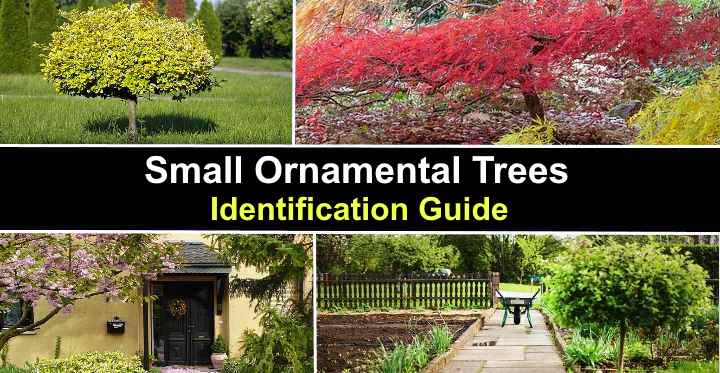
Small ornamental trees are the perfect addition to add charm and beauty to your garden landscape. Not only do small decorative trees add color, texture, and fragrance to an outdoor space, but they also offer shade and privacy. Small ornamental trees for landscaping compact yards can also create a welcoming space without taking up much room.
Choosing the right small ornamental tree for your space can be challenging. Decorative trees may look small in the nursery. However, knowing their mature size and care requirements is vital to ensure the small tree fits your yard and landscape design. Additionally, it’s important to identify which tree will thrive in your climate and soil conditions.
This article is an identification guide to small ornamental trees. Descriptions and pictures of the best small trees for landscaping will help you choose the perfect tree to add beauty to your garden. You will also learn about the growth habits, foliage, and flowers of each tree species.
What Makes Small Trees Ornamental?
Small ornamental trees create visual interest and appeal throughout the seasons. Decorative trees for landscaping typically grow 10 to 15 ft. (3 – 4.5 m) tall. They are ideal for compact backyards or front-of-the-house planting. They also perform well as understory trees in larger landscapes. Beautiful small trees include the weeping Japanese maple, crabapple, and star magnolia.
Several characteristics give small trees ornamental qualities. Apart from their low height, decorative trees may have fragrant flowers, colorful leaves, spectacular autumn foliage, or an interesting shape. For example, many low-growing weeping trees add beauty and aesthetic appeal to small landscapes without dominating the front or backyard.
Here are some common features of small ornamental trees:
- Dwarf growing habit with a maximum height of 10 ft. (3m)
- Fragrant flowers with showy petals and shapes
- Colorful foliage like bronze, deep red, or purple
- Unusual shapes, such as weeping or twisted branches
- Evergreen trees with columnar habits and fastigiate branches growing parallel to the trunk
- Attractive bark with interesting textures
The Best Small Ornamental Trees (With Pictures)
The following are some of the best small ornamental trees to add charm and beauty to your garden. Learn about the growth habit, foliage, and flowers of each tree species to determine which one is right for you.
Eastern Redbud (Cercis canadensis)
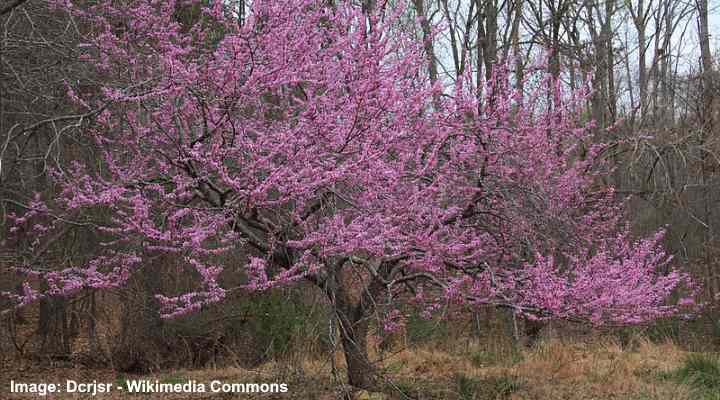
Eastern redbud is a beautiful small flowering tree that will enhance any garden landscape
The Eastern redbud is a small ornamental tree that blooms in early spring with clusters of pink-purple flowers. Its decorative appeal continues when the redbud’s heart-shaped leaves turn bright yellow in the fall. Compact in size, many eastern redbud varieties grow 9 to 12 ft. (2.7 – 3.6 m) tall with a spread up to 15 ft. (4.5 m).
Eastern redbud trees are decorative and perfect for increasing curb appeal in front yards. These small trees thrive in full sun or partial shade and prefer well-drained, moist soil. They make a colorful and low-maintenance addition to your landscape.
Here are some varieties of eastern redbuds in the category of “small ornamental trees”:
Eastern redbud ‘Ace of Hearts’: Ornamental features of this redbud tree are its bright reddish-purple flowers, vase shape, and irregular branching pattern. It grows 9 to 12 ft. (2.7 – 3.6) tall.
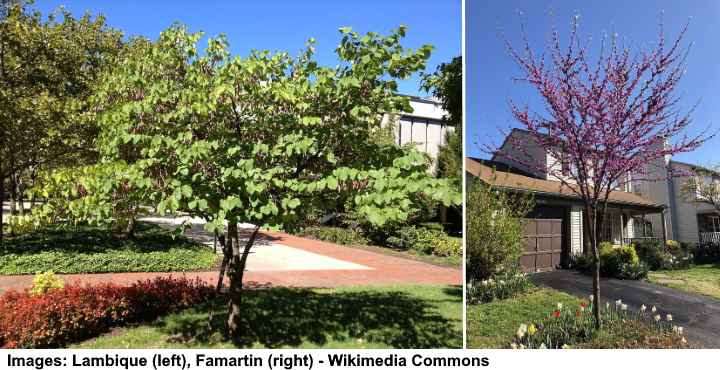
Eastern redbud ‘Ace of Hearts’
Redbud’ Ruby Falls’: Decorative features of this redbud are its dark rose flowers, maroon-red heart-shaped leaves, and pendulous branching habit. It grows 5 to 6 ft. (1.5 – 1.8) tall.
Eastern redbud ‘Tennessee Pink: This ornamental redbud features a dome-shaped canopy, bright pink flowers, and yellow foliage in the fall. It grows 9 to 12 ft. (2.7 – 3.6 m) tall.
Eastern redbud ‘Lavender Twist’: The weeping eastern redbud features lavender-pink flowers covering cascading branches in the spring. Like all redbuds, it has golden yellow fall colors. It grows 5 to 6 ft. (1.5 – 1.8 m) tall.

Eastern redbud ‘Lavender Twist’
Mature Size: 9 to 12 ft. (2.7 – 3.6 m) tall and up to 15 ft. (4.5 m) wide
USDA Hardiness Zones: 4 to 9
Sun: Full sun to partial shade
Fringe Tree (Chionanthus virginicus)

The small deciduous and low-maintenance fringe tree has white scented flowers
The fringe tree is a sun-loving low-growing decorative tree with showy, fragrant white flowers in spring. The outstanding feature of the ornamental tree is its clusters of slender fringe-like petals dangling from branches. The fragrant flowers and lance-shaped leaves covering spreading branches are attractive in small to medium-sized gardens.
Fringe trees grow 12 to 20 ft. (3.6 – 6 m) tall and wide. They thrive in full sun or partial shade in USDA zones 3 to 9. They perform well in moist, well-drained soils and don’t tolerate drought. The low-maintenance tree is an ideal specimen plant, small shade tree, or accent tree in a sunny landscape.
Another ornamental feature of fringe trees is when the white petals drop to the ground. They form a snow-like covering under the small tree.
Mature Size: 12 to 20 ft. (3.6 – 6 m) tall and wide
USDA Hardiness Zones: 3 to 9
Sun: Full sun
Dwarf Serviceberry (Amelanchier ‘La Paloma’)

The white flowers of dwarf serviceberry tree give ornamental value to compact gardens
Dwarf serviceberry is a beautiful multi-stemmed small tree with masses of ornamental white flowers and edible red or purple berries. Decorative features of this small tree are its showy, white, fragrant flowers, bronze-red leaves that turn dark green, and stunning orange and red fall foliage. Additionally, it has attractive light-gray bark.
Dwarf serviceberry tree grows 8 to 15 ft. (2.4 – 4.5 m) tall and wide. Ideal for sunny landscapes, you can grow the decorative tree as a specimen plant, foundation planting, hedge, or shrub border. The compact shrub works well in mixed borders, cottage gardens, or naturalized areas.
Dwarf serviceberry is suitable for planting in USDA zones 4 through 8 and is generally disease and pest free.
Mature Size: 8 to 15 ft. (2.4 – 4.5 m) tall and wide
USDA Hardiness Zones: 4 to 8
Sun: Full sun
Small Crape Myrtle Tree (Lagerstroemia)
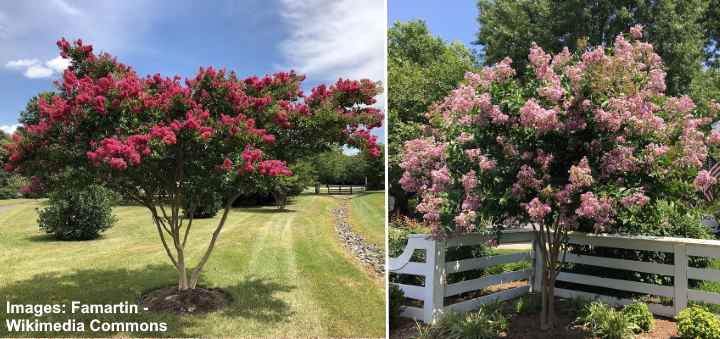
Crape myrtles are small flowering trees that grow best in full sun and are suitable for limited spaces
Small crape myrtle trees have tremendous ornamental appeal thanks to their showy pink, red, white, or purple flower clusters. The stunning clusters of flowers are crinkly petals grouped in conical panicles. The outstanding floral display contrasts nicely with the leathery, glossy leaves. Many varieties of dwarf crape myrtle trees rebloom in late summer.
Small crape myrtle varieties typically grow 5 to 12 ft. (1.5 – 3.6 m) tall and have a spreading canopy. These small decorative trees are excellent container plants for patios and balconies. You can also plant them along a foundation line, in borders, or create an informal hedge.
Small crape myrtle trees are suitable for growing in USDA zones 7 to 10.
Here are a few varieties of small crape myrtle trees for compact gardens:
Acoma Crape Myrtle (Lagerstroemia indica x fauriei ‘Acoma’): The ornamental feature is its showy clusters of white flowers with a ruffled appearance.
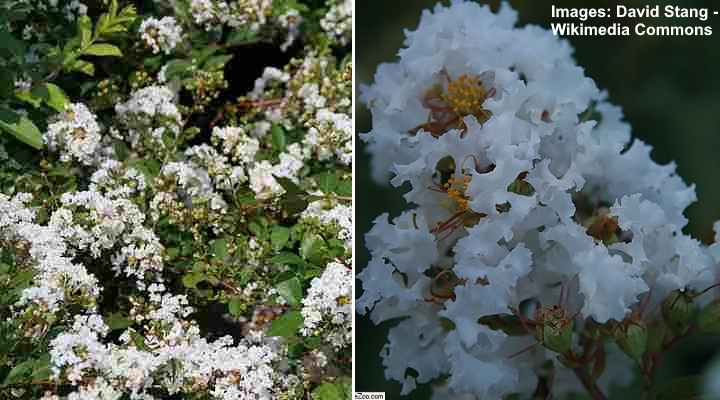
Acoma crape myrtle (Lagerstroemia indica x fauriei ‘Acoma’)
Tonto Crape Myrtle (Lagerstroemia indica x fauriei ‘Tonto’): The small beautiful tree has pinkish-red flowers and leathery leaves that turn purple-red in the fall.

Crape Myrtle Tonto (Lagerstroemia indica x fauriei ‘Tonto’)
Rhapsody in Pink Crape Myrtle (Lagerstroemia indica ‘Whit VIII’): Growing 6 to 10 ft. (1.8 – 3 m) tall, this pink compact flowering tree has ruffled light pink blooms in spring growing in dense clusters.

Lagerstroemia indica ‘Whit VIII’
Mature Size: 5 to 12 ft. (1.5 – 3.6 m)
USDA Hardiness Zones: 7 to 10
Sun: Full sun
Small Magnolia Trees (Magnolia sp.)
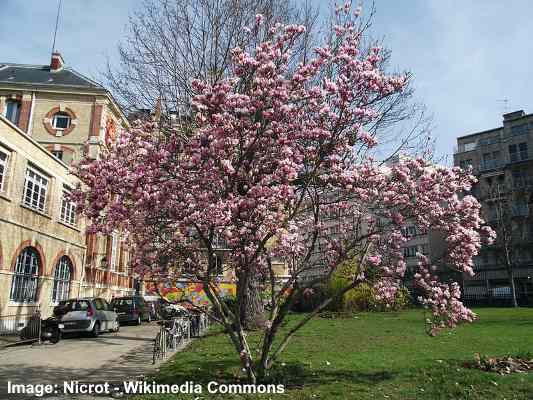
Saucer magnolia ‘Lilliputian’ (Magnolia soulangeana ‘Lilliputian’) is the smallest of the saucer magnolias and is suitable for compact gardens
Small magnolia trees are stunning landscaping trees for compact, sunny yards. The decorative value of magnolia trees is their large, sweetly-scented fragrant flowers and eye-catching yellow foliage in the fall. Small magnolia trees grow 6 to 15 ft. (1.8 – 4.5 m) tall, depending on the variety.
Here are a few varieties of compact magnolia trees suitable for tight spaces in small yards:
Star Magnolia (Magnolia stellata): The tree’s ornamental characteristics are its fragrant white flowers, glossy green foliage, and irregular branching habit. It grows 6.5 ft. (2 m) tall.
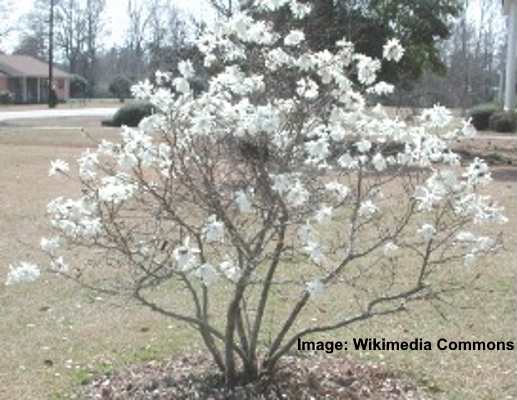
The small flowering star magnolia tree is a beautiful landscaping tree
Magnolia ‘Ann’: This small magnolia for landscaping has chalice-shaped purple-pink flowers. This elegant decorative tree grows 8 to 10 ft. (2.4 – 3 m) tall and wide.
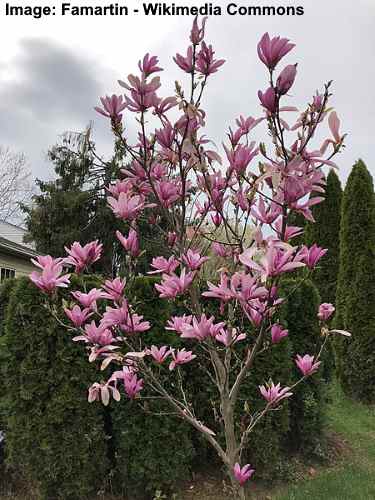
Magnolia ‘Ann’
Magnolia x loebneri ‘Encore’: The white, star-shaped flowers with 20 to 25 petals are the outstanding feature of this ornamental magnolia tree. It grows 8 to 15 ft. (2.4 – 4.5 m) tall and wide.
Mature Size: 6 to 15 ft. (1.8 – 4.5 m)
USDA Hardiness Zones:
Sun: Full sun
Fernleaf Full Moon Maple Tree (Acer japonicum ‘Aconitifolium’)
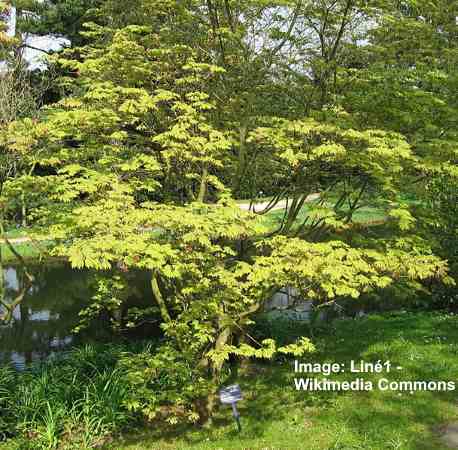
The dwarf ornamental fernleaf full moon maple is a compact deciduous tree with attractive feathery foliage and autumn color
Small Japanese maples are beautiful ornamental trees featuring bright red or scarlet foliage in the fall. The slow-growing dwarf trees feature delicate, fern-like leaves, each with seven to 11 pointed lobes. They also have small red flowers, winged maple seeds, and a dense branching habit.
This decorative Japanese maple ‘Aconitifolium’ grows 8 to 10 ft. (2.4 – 3 m) tall and wide. The low-maintenance tree is ideal for planting in small gardens, patios, or as an accent tree. It’s the perfect choice to add brilliant color and texture to a fall garden.
Small Japanese maple trees are suitable for growing in USDA zones 5 to 7.
Mature Size: 8 to 10 ft. (2.4 – 3 m)
USDA Hardiness Zones: 5 to 7
Sun: Full sun to partial shade
Japanese Weeping Cherry (Prunus serrulata ‘Kiku-Shidare-Zakura’)
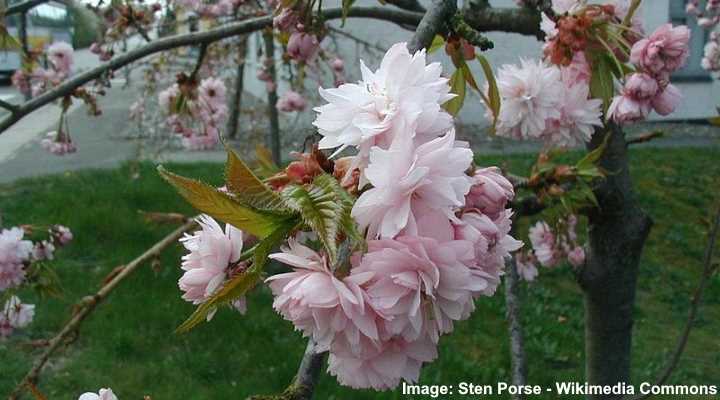
Dwarf Japanese weeping cherry ‘Kiku-Shidare-Zakura’ has stunning ruffled pink flowers
The Japanese weeping cherry tree is a beautiful ornamental tree with cascading branches covered with pink spring blossoms. Also called sakura, the decorative cherry tree has an umbrella-like canopy. After its spring flowers drop, green leaves emerge that turn golden yellow in the fall. The powder-puff blossoms on the gracefully drooping branches measure 1” to 2” (2.5 – 5 cm) across.
The Japanese weeping cherry trees grow 10 ft. (3 m) tall, which is ideal for front yards, lawn trees, or compact back gardens. In addition to spring floral displays, the small trees have shiny coppery bark that peels during winter. Japanese weeping cherry trees thrive in USDA zones 4 to 9.
Mature Size: Up to 10 ft. (3 m)
USDA Hardiness Zones: 4 to 9
Sun: Full sun
Purple Leaf Sand Cherry (Prunus × cistena)

The small purple leaf sand cherry has stunning pink flowers and colorful foliage
The purple-leaf sand cherry is a small ornamental landscaping tree that adds a burst of color to garden landscapes. The decorative outdoor tree features deep purple-red leaves, fragrant pale pink flowers, and stunning fall colors. Purple-leaf sand cherry trees grow 6 to 10 ft. (1.8 – 3 m) tall and wide.
Ornamental cherry trees are ideal for planting as a decorative shrub, colorful hedge, specimen plant, or in mass plantings. Purple leaf sand cherry thrives in full sun and well-drained soil. The plant is suitable for growing in USDA zones 2 to 8.
Mature Size: 6 to 10 ft. (1.8 – 3 m)
USDA Hardiness Zones: 2 to 8
Sun: Full sun
Small Weeping Mulberry (Morus alba ‘Chaparral’)
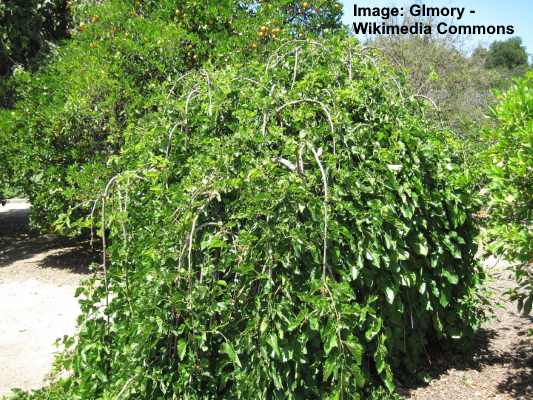
‘Chaparral’ cultivar is a type of dwarf weeping mulberry
The small weeping mulberry is a sun-loving deciduous tree with a decorative shape. The unique weeping habit of the dwarf tree is from its slender branches that cascade downward. These are covered in dark green leaves with serrated margins. Additionally, clusters of yellowish-green flowers give way to edible blackberry-like fruits.
The weeping mulberry tree grows up to 6 to 8 ft. (1.8 – 2.4 m) tall and wide. Its dwarf size means it’s an excellent choice for lawns, front yards, or as a container plant. The small tree is also ideal for planting near flower beds, seating areas, or garden paths, allowing its weeping branches to be admired.
Small weeping mulberry is suitable for planting in USDA zones 5 through 9 and requires full sun and well-drained soil.
Mature Size: 6 to 8 ft. (1.8 – 2.4 m)
USDA Hardiness Zones: 5 to 9
Sun: Full sun
Small Ornamental Crabapple Trees (Malus)

Crabapples are small ornamental trees with flowers that come is shades of pink, purple, red and white
Dwarf ornamental crabapple trees are packed with decorative value. The small trees have beautiful spring blossoms, a zig-zag branching habit, dense foliage, and colorful fruit in the fall. Most small varieties of crabapple trees have a rounded shape with a dense canopy. Ornamental crabapple flowers range in color from white to pink to red, and the fruit can be red, yellow, or green.
Here are some varieties of small crabapple trees:
Sargent crabapple (Malus sargentii): Growing 6 to 10 ft. (1.8 – 3 m) tall, the decorative landscaping tree has masses of white flowers and tiny cherry-size red fruits.

Sargent crabapple (Malus sargentii)
Crabapple’ Spring Snow’: Covered in white spring blossoms, this crabapple tree is a non-fruiting variety. It has an attractive upright, oval habit and yellow fall color.
Crabapple’ Purple Prince’: This ornamental landscaping tree has spectacular floral displays of pink flower clusters in spring. It produces delicious ruby red apples in fall and winter.
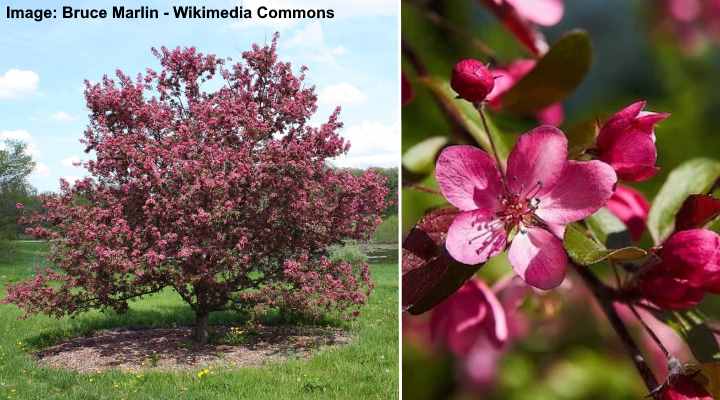
Crabapple ‘Purple Prince’ (Malus ‘Purple Prince’)
The small size of miniature crabapple trees makes them perfect for small yards in USDA zones 4 to 8.
Mature Size: 6 to 25 ft. (1.8 – 7 m)
USDA Hardiness Zones: 4 to 8
Sun: Full sun
Ivory Silk Lilac Tree (Syringa reticulata ‘Ivory Silk’)
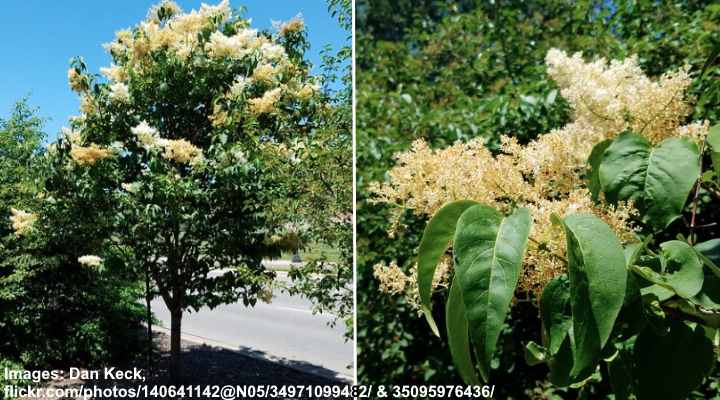
Ivory Silk Lilac Tree
The ‘Ivory Silk’ lilac tree is a beautiful small tree or multi-stemmed shrub suitable for medium-sized yards. The outstanding feature of this lilac tree is its large clusters of fragrant, creamy-white flowers that bloom in late spring to early summer. Also, the decorative tree has dark green lance-shaped leaves and reddish-brown exfoliating bark.
An attractive addition to any landscape, the ‘Ivory Silk’ lilac tree grows 20 to 35 ft. (6 – 7.5 m) tall and 20 ft. (6 m) wide. It’s ideal for planting as a specimen tree, privacy screen, or a small shade tree.
The Ivory Silk Lilac Tree is suitable for growing in USDA zones 3 to 7.
Mature Size: 20 to 35 ft. (6 – 7.5 m) and 20 ft. (6 m) wide
USDA Hardiness Zones: 3 to 7
Sun: Full sun
Pygmy Date Palm (Phoenix roebelenii)
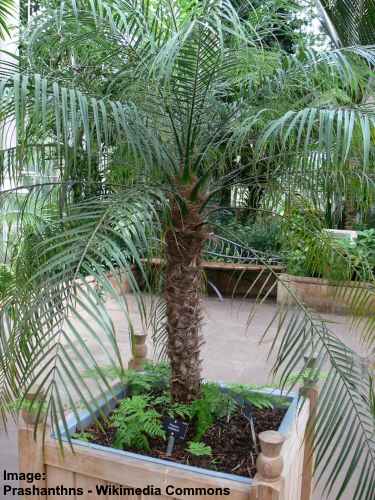
The pygmy date palm is a type of small palm tree with spiky trunk that can also be grown in a container
Add a tropical landscaping feature to a compact yard by growing the pygmy date palm. This small, subtropical palm tree features attractive arching fronds measuring 3 ft. (1 m) long. Also, the landscaping palm produces creamy-yellow flowers and clusters of red and black edible fruits that ripen in late fall.
Pygmy date palm grows 6 to 10 ft. (1.8 – 3 m) tall and is cold-hardy to 26°F (-3°C). It’s a perfect palm tree for small backyards or front gardens as it doesn’t take up much space. It’s also suitable for planting in containers, making it an excellent choice for patios and courtyards.
Pygmy date palm is suitable for growing in USDA zones 9 to 11.
Mature Size: 6 to 10 ft. (1.8 – 3 m)
USDA Hardiness Zones: 9 to 11
Sun: Full sun to partial shade
Small Ornamental Frangipani Tree (Plumeria)
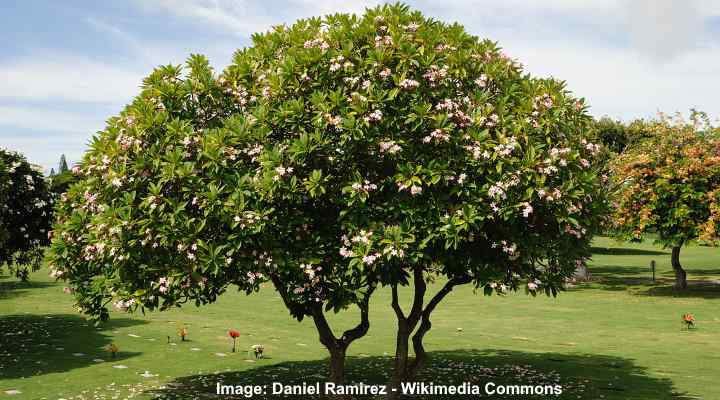
Plumeria tree is a relatively small tropical flowering tree suitable for warmer climates
The small ornamental frangipani tree is a beautiful tropical tree with exotic white, yellow, orange, or pink flowers. The five-petalled flowers bloom in large clusters forming a star shape or pinwheel form. The smaller varieties of Frangipani trees grow 10 to 20 ft. (3 – 6 m) tall and wide.
Small frangipani trees are perfect for landscaping gardens in subtropical and tropical landscapes. The low-maintenance decorative trees withstand drought and heat. And the fragrant flowers attract butterflies and hummingbirds to the garden.
Small ornamental frangipani trees are suitable for growing in USDA zones 10 and 11.
Mature Size: 10 to 20 ft. (3 – 6 m) tall and wide
USDA Hardiness Zones: 10 to 11
Sun: Full sun
Sky Pencil Holly (Ilex crenata ‘Sky Pencil’)
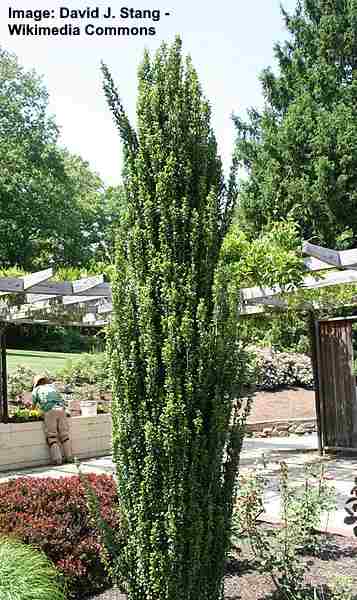
The evergreen ‘Sky Pencil’ holly has narrow growth habit that doesn’t take much space
‘Sky pencil’ holly is a narrow, columnar evergreen tree perfect for adding height to compact garden spaces. The slender tree with its pencil-thin habit grows 6 to 10 ft. (1.8 – 3 m) tall and 3 ft. (1 m) wide. Its glossy, dark green leaves provide a beautiful backdrop for beds with colorful flowers and small flowering shrubs.
‘Sky pencil’ holly is an ideal landscape solution to add a vertical accent to a tiny garden. It’s low maintenance and tolerance to drought and heat. You can also plant ‘Sky Pencil’ holly as a corner-of-the-house plant, privacy screen, or foundation planting. The columnar tree also works well in containers or as a specimen plant.
‘Sky pencil’ holly is suitable for growing in USDA zones 6 to 8.
Mature Size: 6 to 10 ft. (1.8 – 3 m) tall and 3 ft. (1 m) wide
USDA Hardiness Zones: 6 to 8
Sun: Full sun to partial shade
Summer Chocolate Mimosa Tree (Albizia julibrissin ‘Summer Chocolate’)
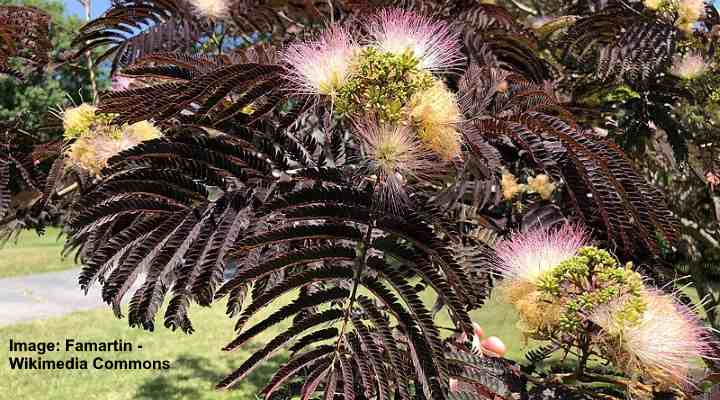
The chocolate mimosa tree is a small deciduous tree with chocolate-burgundy foliage and pink-white fuzzy flowers
Also called the silk tree, the ‘Summer Chocolate’ mimosa tree is a stunning ornamental tree with fern-like foliage and fluffy pink and white flowers. The endearing features of this landscaping tree are its pincushion-like flowers, deep burgundy leaves that mature to dark chocolate brown, and long bean-like seed pods.
The fragrant fluffy pinkish-white flowers contrast nicely with dark foliage. The fast-growing decorative tree grows 15 to 20 ft. (4.5 – 6 m) tall and wide, making it an ideal shade tree or specimen plant in USDA zones 6 to 9.
Mature Size: 15 to 20 ft. (4.5 – 6 m) tall and wide
USDA Hardiness Zones: 6 to 9
Sun: Full sun
Small Ornamental Chaste Tree (Vitex agnus-castus)

Chaste tree can be trained to grow as a multi-stemmed or single-trunked tree and has purple, pink or white flowers
The chaste tree is a small decorative tree with clusters of fragrant purple or blue-violet flowers that bloom in late summer. Also known as monk’s pepper, this deciduous tree has grayish-green aromatic leaves, pink, white, or lavender flower clusters, and rounded drupes in the fall.
The small tree can be trained to grow as a single-trunked tree 8 to 10 ft. (1.8 – 3 m) tall. The drought-tolerant tree also works well in cottage gardens, mixed borders, and xeriscapes. The blue-violet flowers also make for excellent cut flowers and dried floral displays.
Small ornamental chaste tree is suitable for growing in USDA zones 7 through 9.
Mature Size: 8 to 10 ft. (1.8 – 3 m)
USDA Hardiness Zones: 7 to 9
Sun: Full sun
Japanese Flowering Quince (Chaenomeles Japonica)
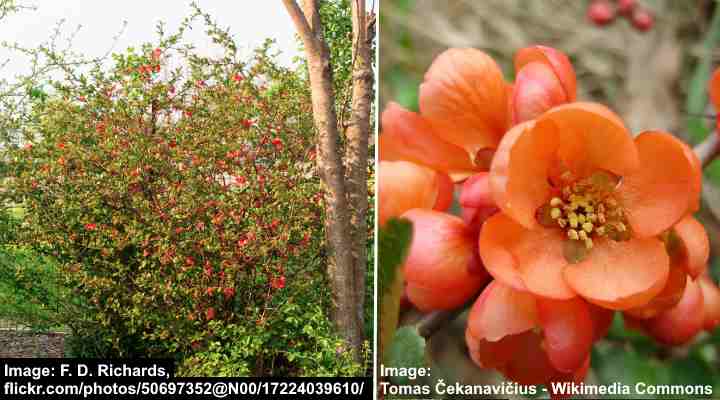
The Japanese Flowering Quince is a miniature ornamental tree known for its beautiful clusters of orange-scarlet, cup-shaped flowers with golden yellow stamens. The tree’s rounded canopy shape adds to its charm and elegance. After the flowers fade, the tree produces round, golden-yellow to light-green apple-like fruits. The leaves are lanceolate, glossy, and display a mid-green shade.
The small decorative Japanese Flowering Quince tree grows best in well-drained soil. It is incredibly versatile and can be used in various ways to improve your landscape. You can use it as a low-flowering hedge, a lovely shrub border plant, or a striking specimen plant. In addition, its thorny branches make it an excellent option for creating a secure and effective security screen around your backyard.
Mature Size: 2 to 3 ft. (0.6 – 1 m) tall and 3 to 6 ft. (1 – 1.8 m) wide
USDA Hardiness Zones: 5 to 9
Sun: Full sun to partial sun
Chinese Plum Tree (Prunus glandulosa)
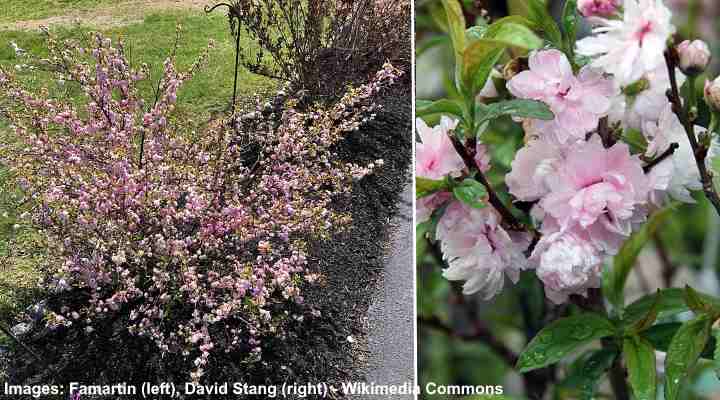
The Chinese plum tree is a dwarf ornamental shrub-like tree characterized by its stunning clusters of fragrant, pinkish-white flowers that bloom in the spring. This attractive tree has pointy, ovate leaves that transition into a yellow hue during the fall. In addition, it produces round, dark red fruits that create a stunning contrast against the green foliage, enhancing its overall visual appeal.
Chinese plum trees adapt to most soil types, as long as they are well-drained. Grow this ornamental tree as a striking focal point or an elegant accent plant in your garden. Its presence is guaranteed to enhance the overall beauty of your landscape.
Mature Size: 4 to 5 ft. (1.2 – 1.5 m) tall and wide
USDA Hardiness Zones: 4 to 8
Sun: Full sun to partial shade
Yellow Oleander (Cascabela thevetia)

The yellow oleander is an attractive evergreen shrub or small tree. Its flowers are a striking golden-yellow and trumpet-shaped, found in sparse clusters at the ends of its branches. This ornamental tree also has elongated, glossy green leaves, providing a stunning contrast against the bright yellow blooms. During late summer to autumn, the tree produces round, green seed pods that turn red-black when ripe, enhancing its overall appeal.
The yellow oleander thrives in moist, well-drained soil. This attractive tree is well-known for its decorative features, but it’s essential to note that all parts of the tree are highly toxic. Exercise caution when planting around children or pets. Despite this, its lush, glossy green foliage and rounded canopy shape make it an excellent choice for ornamental purposes, creating an eye-catching focal point or accent plant.
Mature Size: Up to 8 ft. (2.4 m) tall and 4 ft. (1.2 m) wide
USDA Hardiness Zones: 8 to 10
Sun: Full sun to partial shade
Weeping Scotch Laburnum (Laburnum alpinum ‘Pendulum’)
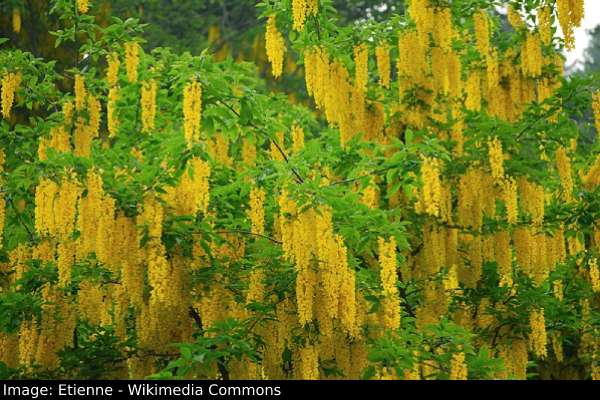
The weeping scotch laburnum is a beautiful decorative tree, identified by its fragrant, pendulous yellow flowers. Its lush, glossy green foliage and umbrella-shaped canopy add to its charm, making it an attractive choice for enhancing your garden’s appearance.
Plant this tree in any well-draining soil. This ornamental tree serves as an ideal focal point or accent plant in your garden. In addition, its cascading branches and small size make it a good choice for small yards or tight spaces. With its graceful appearance and fragrant yellow flowers, the weeping scotch laburnum is sure to add beauty and elegance to your landscape.
Mature Size: 6.5 to 8 ft. (2 – 2.5 m) tall and up to 6.5 ft. (2 m) wide
USDA Hardiness Zones: 5 to 7
Sun: Full sun or partial shade
Flame Azalea (Rhododendron calendulaceum)

The flame azalea is an ornamental deciduous shrub or small tree, known for its bright orange to reddish-orange, showy star-shaped flowers. The plant’s leaves are elliptic to ovate, featuring a mid-green color and a slightly hairy texture on both sides. The leaves turn a spectacular red or yellow before dropping in late autumn.
The flame azalea grows best in acidic, moist, well-drained soil. This charming decorative tree is an excellent choice for use as a privacy screen, flowering hedge, or focal point.
Mature Size: 4 to 8 ft. (1.2 – 2.4 m) tall and wide
USDA Hardiness Zones: 5 to 8
Sun: Partial shade or full sun
Waratah (Telopea speciosissima)

The waratah is a stunning, decorative large shrub or small tree, renowned for its vibrant, bright red flower heads that bloom during spring. The base of the flower head features large, ornamental leafy bracts that range in color from red, maroon, to pink. The tree has dark green, leathery leaves with serrated edges.
For the waratah tree to thrive, it’s essential to plant it in well-drained soil. With their gradual growth and tightly packed, dense appearance, these ornamental trees serve as excellent focal points in gardens or as solitary specimen trees. Their uniquely-shaped flowers make them a favorable choice for cut flower arrangements.
Mature Size: 3 to 10 ft. (1 – 3 m) tall and wide
USDA Hardiness Zones: 8 to 10
Sun: Full sun to partial shade
Red Flowering Grevillea Trees
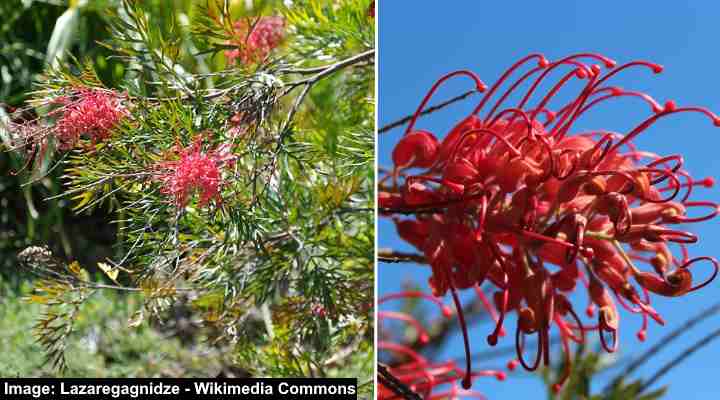
The red flowering grevillea is a decorative evergreen tree renowned for its cylindrical clusters of bright red flowers. The red flowers, with their unique, curled petals and protruding stamens, are especially inviting to birds and bees, making them a valuable addition to any landscape or garden. This ornamental tree also has slender, fern-like leaves that are dark green to silver-gray.
For optimal growth, it is crucial to plant the flowering grevillea tree in well-draining soil. Grevillea trees are highly versatile and can serve as excellent hedges, screens, or specimen plants, adding both beauty and functionality to your landscape. With their vibrant blooms, these trees are guaranteed to enhance the aesthetic appeal of your outdoor space.
Mature Size: 4 to 8 ft. (1.2 – 2.4 m) tall, depending on the species
USDA Hardiness Zones: 9 to 11
Sun: Full sun to partial shade
Common Lilac (Syringa vulgaris)
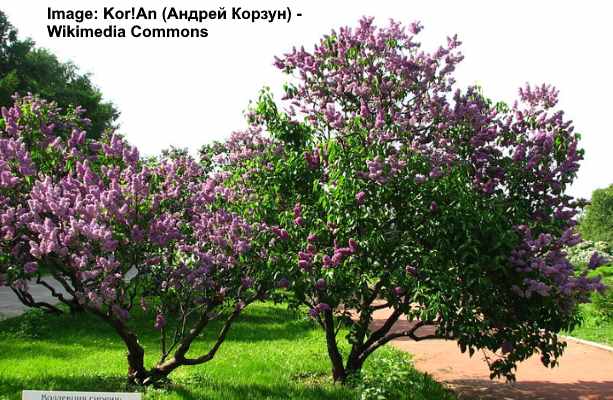
Lilac tree
The common lilac is a beautiful ornamental shrub that can be shaped into a miniature tree. It is known for its attractive bushy form and delightful cone-shaped clusters of highly fragrant, pinkish-purple flowers. Lilac flowers also come in delightful hues of white, pink, or blue. Its leaves are heart-shaped and range from bluish-green to dark green in color, adding a touch of decorative charm to its overall appearance.
For best growth, plant the common lilac in moist, well-drained soil. This shrub-like tree has dense and appealing foliage, making it perfect for hedges, privacy screens, or as a standalone tree. These plants are a great choice for your garden, providing reliable spring blooms and a powerful fragrance that attracts bees and butterflies.
Mature Size: 8 to 10 ft. (2.4 – 3 m) tall and 5 to 6 ft. (1.5 – 1.8 m) wide
USDA Hardiness Zones: 3 to 8
Sun: Full sun for best flowering
Angel’s Trumpet (Brugmansia suaveolens)
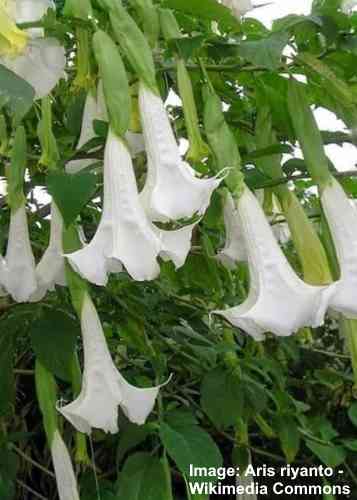
The angel’s trumpet is a small ornamental tree known for its pendulous, creamy-white bell-shaped flowers. Its leaves are dark-green, ovate, and covered with a thin layer of fine hairs. The tree has a dense, vase-like canopy, with branches often spreading widely as it grows.
The angel’s trumpet thrives in fertile, organically rich soil that is well-draining. This unique small ornamental tree is ideal for enhancing garden beds and borders, serving as a captivating focal point, or infusing patios and decks with a tropical ambiance. Note that the plant is toxic when ingested, so be cautious when planting in areas frequented by children or pets.
Mature Size: 3 to 8 ft. (1 – 2.4 m) tall and 2 to 4 ft. (0.6 – 1 m) wide
USDA Hardiness Zones: 9 to 11
Sun: Full sun or partial shade
Flowering Maple ‘Victor Reiter’ (Abutilon ‘Victor Reiter’)
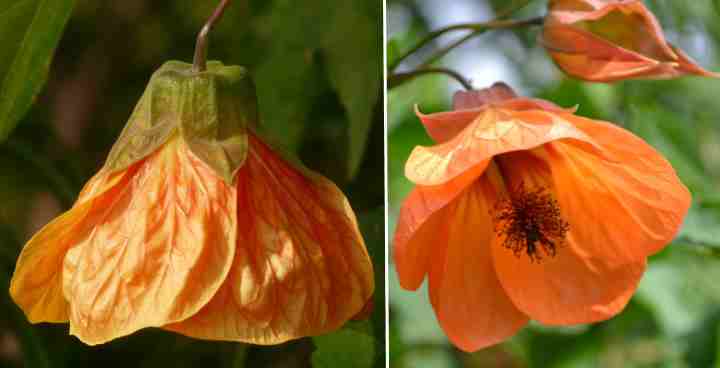
The ‘Victor Reiter’ flowering maple stands out as a captivating ornamental tree, characterized by its charming light-orange, bell-shaped flowers. These elegant blossoms gracefully dangle from the branches, enhancing the tree’s beauty, while their greenish-yellow centers add a delightful touch to the overall appearance. The tree also has maple-like, dark-green leaves that contrast beautifully against the orange blooms.
Flowering maples flourish in soil that drains well, remains consistently moist, and is enriched with organic matter. Flowering maples, with their beautiful orange blossoms, offer an excellent decorative option for adding a burst of color to small gardens, container gardens, or as a centerpiece in any landscape.
Mature Size: 6 to 8 ft. (1.8 – 2.4 m) tall and 4 ft. (1.2 m) wide
USDA Hardiness Zones: 9 to 11
Sun: Full sun to partial shade
Related articles:
